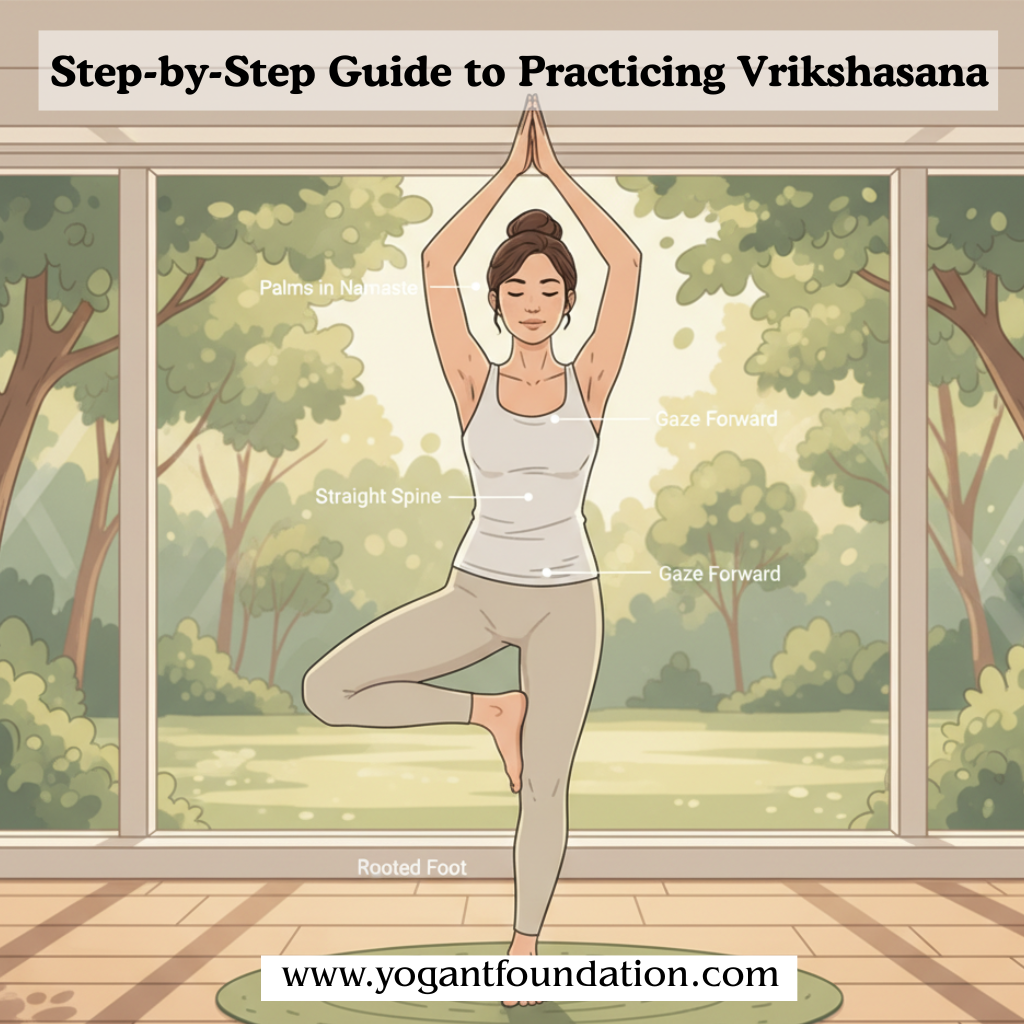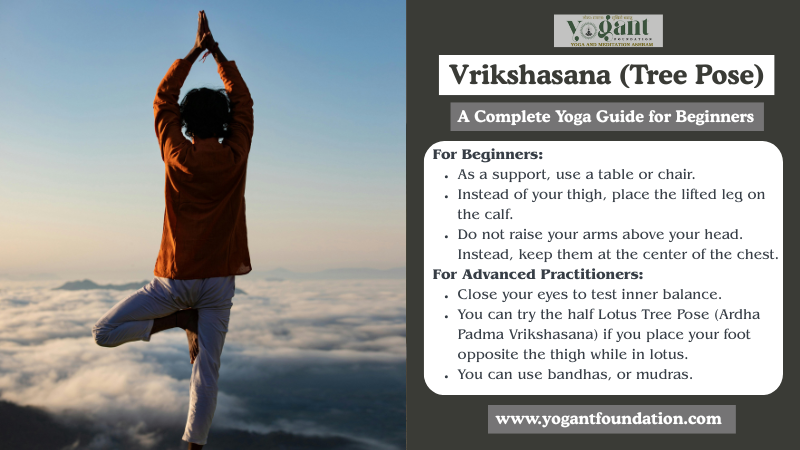Introduction to Vrikshasana
Vrikshasana (also known as Tree Pose) is a graceful and grounding posture in yoga. The pose represents stability, balance, and growth. Sanskrit’s “Vriksha”, meaning tree, and “Asana”, means position or position. Together, Vrikshasana represents an important yoga pose that helps to calm the mind and bring stability into life.
It is easy to see that this yoga pose has a powerful effect. It improves posture alignment and mental focus when practiced consistently. Tree Pose, in the yoga philosophy, is also associated with spiritual opening. This pose represents a human being who grows from strength, nourished and supported by awareness.
Meaning and Symbolism of Vrikshasana
Vrikshasana, too, has deep significance. A tree embodies stability, patience, and nourishment–qualities essential for personal growth. Yoga practitioners use this pose to expand upwards while grounding themselves.
- The root’s leg symbolizes stability and power.
- The arms raised symbolize openness, aspiration, and hope.
- The posture of balance represents harmony within the mind, body, and soul.
Vrikshasana teaches us to stay grounded and center in all storms. This keeps us strong and calm.

Step-by-Step Guide to Practicing Vrikshasana
Vrikshasana is a pose that requires concentration and balance. This pose can be safely performed by following the step-by-step directions:
1. Begin in Tadasana (Mountain Pose)
- Maintain a straight posture with legs together and arms extended at the sides.
- Do not put equal weight on each foot.
- Breathe deeply to help you center your body and mind.
2. Shift Your Weight
- As you shift weight, slowly place your leg on the.
- Hold the leg to your left firmly and firmly.
3. Lift and Place the Right Foot
- Put your right leg on your inner left leg.
- The toes and heel must both be pointed downward.
- It is possible to place your foot instead on the inner calves.
4. Balance Your Posture
- As soon as you’re stable, place your hands in the namaste mudra.
- Focus your gaze on a point fixed in front.
- Maintaining balance and concentration is easier with this.
5. Raise Your Arms
- Stretch your arms and inhale.
- Join your palms or keep them slightly apart.
- Lean your spine upward and lift your chest.
6. Hold and Breathe
- For 20 to 30 second, maintain the most comfortable position possible.
- As you breathe slowly, your body will calm down.
7. Release the Pose
- Bring your arms to the floor and exhale.
- Return to the upright position by releasing your leg.
- Then repeat the process on the second side.
Top 7 Vrikshasana Benefits
Vrikshasana is a holistic practice that offers health benefits for both physical and mental well-being. These are the most important benefits.
1. Enhances Stability and Balance: Vrikshasana helps you to improve your balance. You can maintain your physical balance by strengthening the core muscles and stabilizing legs.
2. Strengthening the Legs and Ankles: With regular practice, the lower body becomes stronger and your endurance improves. The risk of injury is reduced.
3. Enhances Focus and Concentration: Vrikshasana is a great way to improve mental clarity, as it demands intense concentration in order for you to maintain balance. The practice is particularly helpful to people who are dealing with an unfocused or restless brain.
4. Promoting Postural Awareness: Vrikshasana helps correct postural problems and improves body awareness by elongating and strengthening the spine.
5. Sciatica Relief and Flat Feet: By improving circulation and strengthening the muscles of the lower body, this asana provides gentle relief for those who suffer from Sciatica. The asana helps to correct flat feet with time.
6. Calms Mind and Reduces Stress: This pose reduces anxiety by calming the nervous system with deep breathing. This pose creates an awareness of peace and meditative calm.
7. Boosts Self-Confidence: It is not just about building physical strength that one can do this, but it’s also about developing self-confidence. It is through this posture that you can gain emotional stability.
Precautions and Contraindications
Vrikshasana may be safe, but there are some precautions that you need to remember:
- You should avoid it if you are suffering from vertigo, severe pain in the knee, or injury to your ankle.
- People with High or Low Blood Pressure should be guided when practicing.
- For pregnancy women, a modified version should be performed with wall support.
- Before attempting any balance poses, warm your body up.
Modifications and Variations of Vrikshasana
Yoga welcomes every practitioner- whether beginner or advanced. You can try the variations to help you balance.
For Beginners:
- As a support, use a table or chair.
- Instead of your thigh, place the lifted leg on the calf.
- Do not raise your arms above your head. Instead, keep them at the center of the chest.
For Advanced Practitioners:
- Close your eyes to test inner balance.
- You can try the half Lotus Tree Pose (Ardha Padma Vrikshasana) if you place your foot opposite the thigh while in lotus.
- You can use bandhas, or Mudras.
Vrikshasana – The Spiritual Significance
Vrikshasana does not only involve physical activity, but also a religious experience. This helps to cultivate balance in the body-soul. The Tree Pose is a symbol of patience and growth.
The ancient texts of yogic thought hold that trees are sacred entities, connecting Earth (roots and branches) with Heaven (branches and leaves). In the same way, when practicing Vrikshasana you your rooted leg symbolizes grounding to reality, and your extended arms symbols spiritual aspiration.
The balance of this pose teaches a great lesson in yoga: how to stay grounded and reach for higher consciousness.
Connection with Chakras
Vrikshasana has a direct impact on the Muladhara (Root Chakra), as well as the Anahata (Heart Chakra).
1. Muladhara Chakra (Root Chakra)
Located at the base or your spine, the survival and stability chakras govern the foundation of your body. Vrikshasana opens this chakra to help you feel grounded, secure, and balanced.
2. Anahata Chakra (Heart Chakra)
Your Heart Chakra will be stimulated as you open your chest and stretch upwards. This promotes compassion, love, and opening.
Vrikshasana, through this connection, harmonizes both lower and upper energies- balancing physical stabilization with emotional expansion.
Breathing Technique During Vrikshasana
In order to maintain balance, breathing is important. To get the best results from pranayama, you should follow this practice pattern.
- While you stretch your spine and lift your arms, inhale deep.
- Exhale slowly, and then place one foot down on the floor.
- Continue to breathe slowly and in rhythm.
- Do not hold your breath. Let the energy flow.
The combination of Pranayama with Vrikshasana increases concentration, mindfulness, and oxygen intake.
Vrikshasana: A Daily Life Practice
This pose is more than just a practice of yoga. It represents a way of life. Returning to the Tree Pose when your life is unsteady reminds you of how important it is to be rooted to values while adaptable in your approach.
Practicing Vrikshasana regularly:
- The resilience to emotional stress is improved
- Enhances the ability to make decisions
- Promotes mental quietness amid chaos
- Promotes brain-body coordination
Vrikshasana is a great way to start the day.
Common mistakes to avoid
Many beginners make mistakes in their posture or balance. Here are a few tips on how to improve your pose.
- Avoid pressing the heel on your knee. It could cause a knee injury.
- Don’t hunch shoulders– Keep chest and spine open.
- Breathe smoothly.
- Maintain a neutral pelvis. Avoid leaning on one side.
- Slow down. Balance does not come from speed, but stillness.
Mindful practice prevents injury, and it enhances the meditation experience.
How Long Should You Hold Vrikshasana?
The length of time you spend on each leg depends upon your comfort level and experience. Beginners are advised to start at 15-20 seconds and then progress up to 1 minute on each leg. The advanced practitioner can continue to hold the pose for 3 minutes. The focus should be on maintaining awareness as well as a steady breathing.
The Best Time to Practice Vrikshasana Tree Pose
- The morning practice refreshes the mind and gives you the energy to face your day.
- After work, you can perform this exercise in the evening to relieve your mind.
- Make sure your stomach and bowels are empty. This should be done after 4 to 6 hours.
Vrikshasana and Mindfulness
Vrikshasana can be described as moving mediation. Mindfulness is required to balance on one foot. This requires mindfulness, body awareness, and controlled breath.
Observe how your mind moves as you maintain the posture. Be aware that your balance will change as your focus changes. It is important to learn how to maintain focus in the face of distractions.
Vrikshasana: A Guide for Professionals and Students
Vrikshasana for students is an effective tool that can enhance focus and memory. This technique trains your brain to remain alert and focused.
Working professionals can use it to improve their posture and keep up energy during long hours of work. Vrikshasana is a great way to improve mental clarity and creative thinking.
Vrikshasana and Yogic Philosophy
The tree represents the relationship between earth and heaven. While its deep roots symbolize discipline and grounding while its branches represent the desire for spiritual growth,
Meditation in Vrikshasana, is a way to balance material stability with spiritual elevation. The practice of Vrikshasana teaches the ability to be calm and steady, no matter what happens in life.
Vrikshasana and Nature Connection
Vrikshasana serves as a beautiful reminder of how we are connected to nature. We can connect to the energy of Earth by standing up tall. This is a great pose to do outdoors under a large tree, or even in a beautiful garden.
It is in harmony with the principle of prakriti (nature) that humans and nature can coexist. The practice reduces anxiety and helps us reconnect to our natural rhythms.
Final Thoughts: Cultivating Balance Like a Tree
Vrikshasana represents a life metaphor. You learn to be solid like a tree with a strong foundation, and yet remain flexible in the face of changes.
If you do Vrikshasana every day:
- The muscles in your body become more powerful.
- Relax your mind.
- You will find that your heart becomes more centered.
The asana helps you develop spiritually, mentally, and physically, just like the tree that reaches to the heavens while remaining deeply rooted in the earth.
The next time you put out your yoga mat, stand tall and lift your arms to embrace your inner tree. Vrikshasana can remind you of the fact that you cannot find balance, but you must cultivate it.



